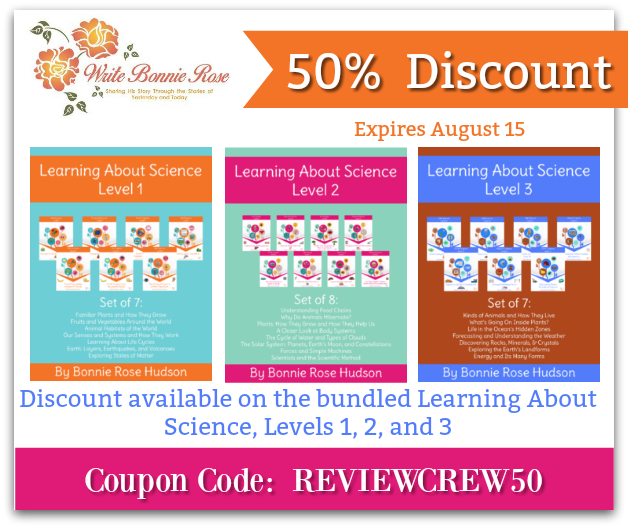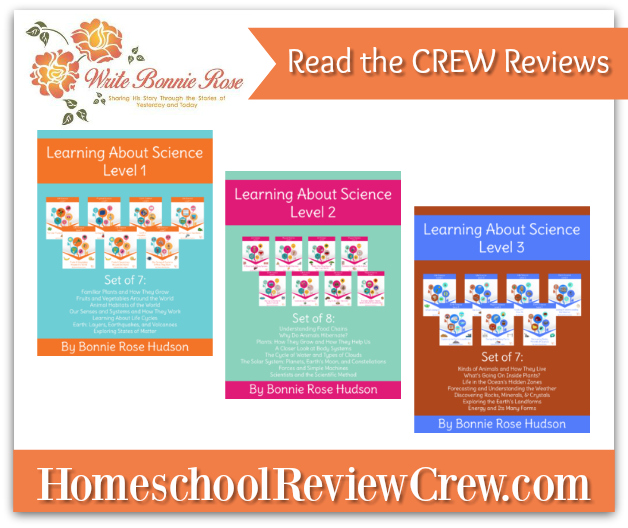As a collective, the kids and I really enjoy unit studies that focus on one particular topic. I think the kids learn the material a bit better when what they are working on focuses on a specific topic rather than several topics together. That's why I've really enjoyed using the Learning About Science Collection, Level 3 (Print)collection from WriteBonnieRose with the kids.
WriteBonnieRose is the website of Bonnie Rose and is chalked full of various resources for homeschool families. You may already be familiar with Bonnie Rose as she is the Executive Editor at SchoolhouseTeachers.com and authors many of the classes found there. Her author's blog, WriteBonnieRose, offers a wide variety of educational subjects for students Preschool to High School for nominal prices and even has a wide variety of freebies and resources on her page with even more freebies available for her subscribers.
 |
| WriteBonnieRose Website |
Learning about Science Collection, Level 3 (Print) is a collection of seven study ebooks that cover a wide variety of topics for elementary students. This particular set of study units is available in both Print vs Cursive, depending on preference.
- Discovering Rocks, Minerals & Crystals: Students learn about different types of rocks such as igneous, sedimentary and metamorphic and which minerals fit into each of these categories. Students also learn what crystals are. This study introduces students to 23 different rocks and crystals.This study is 18 pages in length.
- Energy and Its Many Forms: Students are introduced to the five types of energy and their sources. This study also discusses topics such as sound waves, fossil fuels, hydroelectric plants. This study is 26 pages in length.
- Exploring the Earth's Landforms: Learn about beaches, buttes, canyons, gulfs, deserts and more for a closer look at 32 different land forms found on our planet. This study is 18 pages in length.
- Forecasting and Understanding the Weather: Students learn about the different equipment that forecasters use to predict the weather. Students also learn about what is weather as well as extreme weather such as tornado or hurricanes. This unit covers 14 types of weather and is 18 pages in length.
- Kinds of Animals and How They Live: This study covers 9 different types of animals such as vertebrates, invertebrates, reptiles,and arthropods as well as introduces 32 specific animals that fall into each type. This study is 18 pages in length.
- Life in the Ocean's Hidden Zones: In this study, students learn about how the ocean is divided into five distinct zones and about 37 different plants and animals who make their homes in these zones. This study is 21 pages in length.
- What's Going on Inside Plants?: Students learn about the process of photosynthesis and transpiration and how the various parts of the plant work together to move water and light through the plant to create food. This unit is 16 pages in length.
All together, the 7 units provide 135pages of fun learning.
 For this review, the kids and I focused on the longest of the seven units - Energy and Its Many Forms. My review will focus mostly on that particular subject however I have looked at the materials for all seven topics and they all follow the same format.
For this review, the kids and I focused on the longest of the seven units - Energy and Its Many Forms. My review will focus mostly on that particular subject however I have looked at the materials for all seven topics and they all follow the same format.How We Used It:
With seven topics to choose from, it was really hard to pick which study to start with. We ended up flipping a coin to choose between the Oceans Zones study and the Energy study. Heads won out and we dove into the study on Energy and Its Many Forms.
This unit is 26 pages in length and covers the five types of energy seen in everyday life - light, heat, sound, electrical and chemical. After a brief introduction as to what energy is, the study goes into more depth on each type of energy, giving examples of each form.
 |
This study covers a wide variety of vocabulary. On the section in regards to light energy, the kids learned about properties of light and how it can be reflected and refracted. This gave us a great platform for doing a quick experiment to display what they were learning about.
They also learned about Concave and Convex lenses in the light energy section. A few days after we talked about these two ways of bending light, the kids went to the library. In the hands on learning display of the kids section, they found both concave and convex mirrors and had to bring them to show me. I was really surprised that remembered which one was which, but they did. They were also able to determine from Bonnie Rose's description of how the image is altered for our viewing (concave allows big objects to be seen smaller - convex makes small objects look bigger) what type of lens/mirror was found in our telescope and microscope.
At the end of each study is a simple activity review that can be completed after completing the study that will let the student demonstrate that they understand what was learned. The kids both did very well on these reviews.
We elected to receive the print version of these studies, however, the same study is available in a cursive version. The text between these two version are identical. Where they differ is only that instead of having the student print the vocabulary words out on the space provided, they are expected to write in cursive. In both versions, lines are provided with broken letters/guide that the student can trace.
We had a blast working through the Energy unit study and are looking forward to using the other 6 studies in the very near future. I'm already looking as to how I can work the Discovering Rocks, Minerals and Crystals study into our class in the next week or so before we head back to the Museum of Natural History where they have a large collection of rocks and minerals the kids can look at.
If this product looks like something that would really spark your own student's interest in physical science or if maybe one of the other Learning about Science collections, I've got a great offer for you. If you use the code REVIEWCREW50 between now and August 15th, you can get 50% on the bundled Learning About Science collections ( Levels 1, 2, and 3).

For more information about WriteBonnieRose and the large selection of educational materials she has written, be sure to visit the website. You can also find more information on the following social media platforms:
Facebook: https://www.facebook.com/WriteBonnieRose/
Twitter: https://twitter.com/WriteBonnieRose
Pinterest: https://www.pinterest.com/writebonnierose/
.













No comments:
Post a Comment
Note: Only a member of this blog may post a comment.